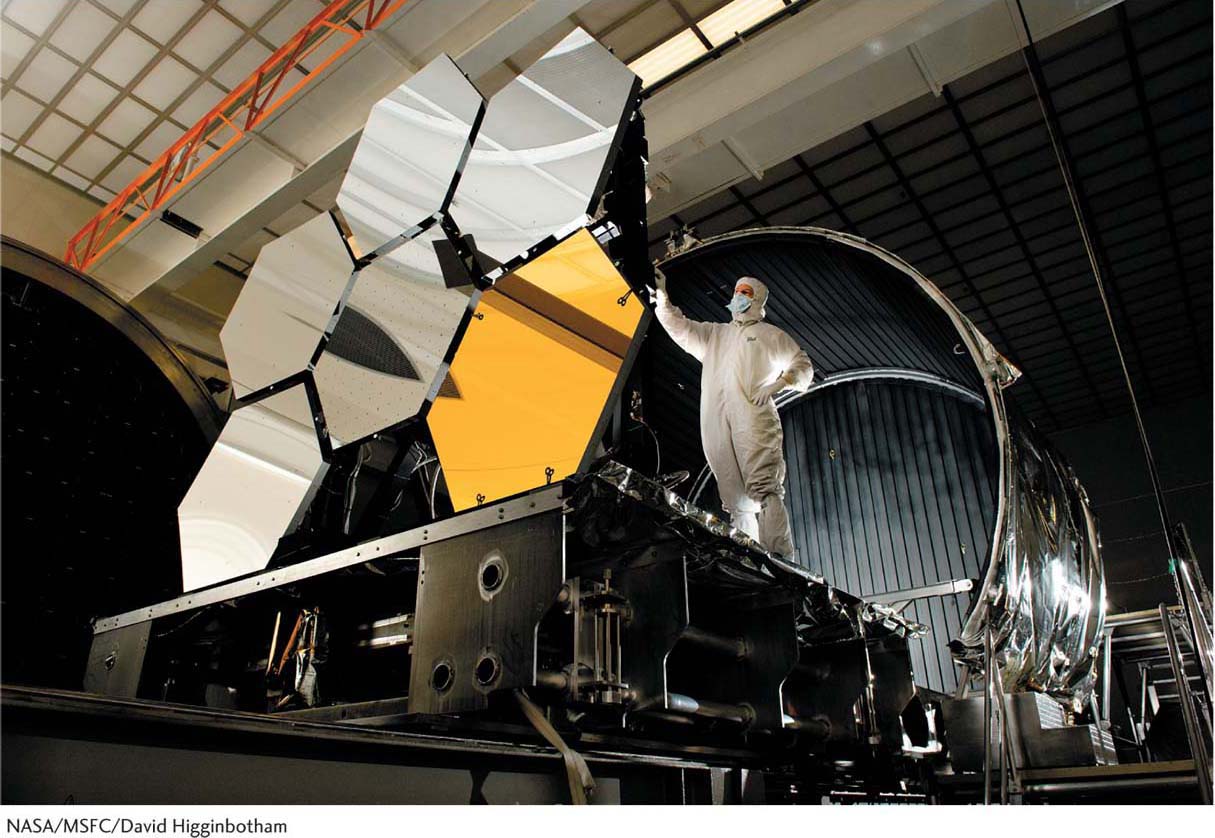5-10 The search for life on exoplanets is under way
The presence of life on Earth has transformed both the atmosphere and surface of our planet. Early plant life transformed Earth’s atmosphere from one that was primarily composed of carbon dioxide and nitrogen to the present atmosphere composed primarily of nitrogen and oxygen. No other mechanism for such a radical transformation is known consistent with the fact that lifeless Venus still has the carbon dioxide and nitrogen atmosphere that it developed 4.5 billion years ago. Life has changed the surface of our planet as a result of forests growing up, cities being built, and land being transformed for agricultural use, among other reasons.
 To date, no life as we know it has been observed on any exoplanet. If life exists on Earthlike planets orbiting in the habitable zones of other stars, we expect to find similar transformations of the exoplanet atmospheres and surfaces as have occurred here. Therefore, astronomers are beginning to study the atmospheres of exoplanets in the hope of finding oxygen-rich ones. These observations are made as starlight passes through or scatters off exoplanet atmospheres. By studying the spectra of this starlight, we can determine the major components of the planetary atmospheres. These observations will be greatly accelerated when the James Webb Space Telescope is launched in 2018 (Figure 5-10). That telescope’s sensitivity to infrared radiation will far eclipse any other such technology we presently have and will allow us to survey many planetary atmospheres in detail.
To date, no life as we know it has been observed on any exoplanet. If life exists on Earthlike planets orbiting in the habitable zones of other stars, we expect to find similar transformations of the exoplanet atmospheres and surfaces as have occurred here. Therefore, astronomers are beginning to study the atmospheres of exoplanets in the hope of finding oxygen-rich ones. These observations are made as starlight passes through or scatters off exoplanet atmospheres. By studying the spectra of this starlight, we can determine the major components of the planetary atmospheres. These observations will be greatly accelerated when the James Webb Space Telescope is launched in 2018 (Figure 5-10). That telescope’s sensitivity to infrared radiation will far eclipse any other such technology we presently have and will allow us to survey many planetary atmospheres in detail.

Figure 5-10: Aerospace lead optical test engineer Dave Chaney inspects six of the 18 primary mirror segments of NASA’s James Webb Space Telescope, prior to cryogenic (extremely low temperature) testing in the X-ray & Cryogenic Facility at NASA’s Marshall Space Flight Center in Huntsville, Alabama. The James Webb Space Telescope will be launched in 2018 to study the formation of the first stars and galaxies and shed new light on the evolution of the universe.
The search for advanced technological civilizations on exoplanets began in 1960, long before the first exoplanet was discovered. Cornell astronomer Frank Drake used a 26-m telescope at the National Radio Astronomy Observatory’s facility in Green Bank, West Virginia, to listen for radio signals that extraterrestrials may be sending. All of the radio signals he detected were random noise. The search for extraterrestrial-generated radio signals is at the heart of the present Search for Extraterrestrial Intelligence (SETI). To date, no radio signals from any intelligent extraterrestrial source have been detected. The search continues! We have more to say about life on other worlds in Chapter 15.
 To date, no life as we know it has been observed on any exoplanet. If life exists on Earthlike planets orbiting in the habitable zones of other stars, we expect to find similar transformations of the exoplanet atmospheres and surfaces as have occurred here. Therefore, astronomers are beginning to study the atmospheres of exoplanets in the hope of finding oxygen-
To date, no life as we know it has been observed on any exoplanet. If life exists on Earthlike planets orbiting in the habitable zones of other stars, we expect to find similar transformations of the exoplanet atmospheres and surfaces as have occurred here. Therefore, astronomers are beginning to study the atmospheres of exoplanets in the hope of finding oxygen-